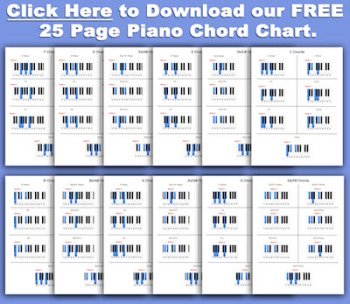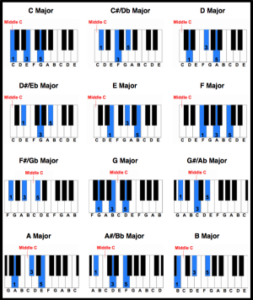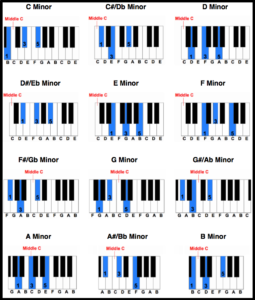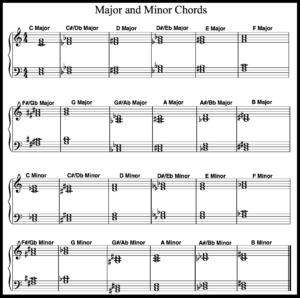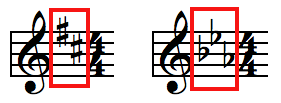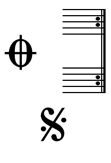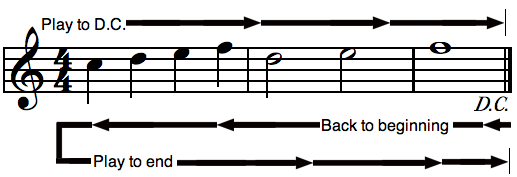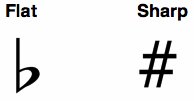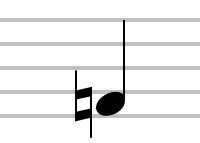We have the most comprehensive Piano Note Chart available for download. Below is a download of the chart which contains a layout of piano keys.
The chart shows the piano keyboard along with the grand staff. It shows each note on the staff and what note on the piano that goes along with that note.
Also, we have a chart showing the treble clef notes and bass clef notes. These charts are helpful so you can remember the notes that fall on the lines and the spaces on the treble and bass clef.
The Piano Note Chart
Here is an image of the piano chart. This chart is an easy to use reference guide that will show you the notes on the staff, and where they are on the piano keyboard.
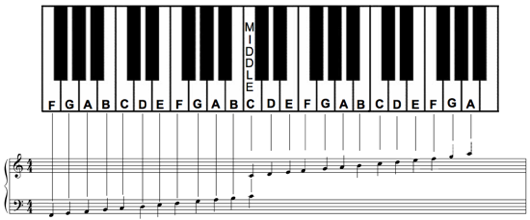
Click Here to download a PDF version of the Piano Note Chart.
The Piano Staff
The staff is made up of two clefs, the treble clef and the bass clef. Each clef tells the musician which hand they should use to play each note. The treble clef, (the top row) is to be played with the right hand, and the bass clef, (the bottom row) is to be played with the left hand.
These two staves are joined together to make what is called the grand staff.
Treble Clef and Bass Clef
These two staffs have notes that lay on either a line or a space. This tells us which note to play on the piano keyboard.
Use the piano note chart below to help you find the notes that fall on the lines and spaces on the treble clef and bass clef.
Treble Clef Spaces

Treble Clef Lines

Bass Clef Spaces

Bass Clef Lines
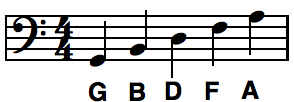
These charts are great to help beginners remember the note names on the piano keyboard.
Learning Piano Keys
Learning the piano keys amy seem difficult but it is actually very easy. There are only twelve notes that you need to learn.
Once you learn these twelve keys all you have to do is repeat them all the way up the piano keyboard. If you need a more extensive lesson on piano keys check out our lessons on piano keys.
If you are still struggling to find the keys and where they are located on the piano you can us our Piano Key Chart. This chart is great to learn the notes and the pattern of the piano keys and did I mention its free to download!
Finding C On The Piano
On the piano note chart I have included Middle C. If you can find C on the piano then you should be able to label all of the other notes.
If you sit at your piano keyboard and find the two black notes that are together and move to the white note that is to the left of them you have found middle C.
If you look up and down the piano keys and find the two black notes together and move one note to the left you will always be on a C. This is helpful because all of the notes on the piano keyboard repeat over and over again. Look at piano keyboard diagram that we have included and you will notice how C repeats itself.
Knowing where middle C is important because this is generally where the notes split between staves. Middle C can be played with the right hand or the left hand, it depends where the note falls on the staff. If it is on the treble clef then you play it with the right hand, if it is on the bass clef then you play it with the left hand.
This note is most generally where the two clefs split. However, this is not always the case.
As you start learning more advanced piano music you will sometimes see that you will need to play some notes lower than Middle C with the right hand and some notes that are above Middle C with the left hand. It all depends on what is more comfortable for the player and what each hand has to play at a certain moment.
If you have to play a high note and a note that is close to Middle C, you will most likely play the high notes with the right hand and the notes around Middle C with the left hand.
I hope these charts have been helpful. Make sure to print it off and set it next to your piano or keyboard are a music tool to help you.
Go From Piano Note Chart Back to Free Piano Lessons
Back to Home Page



